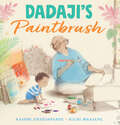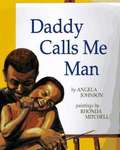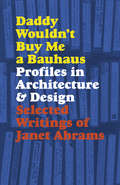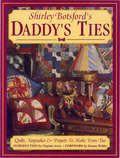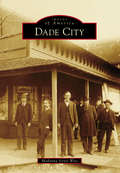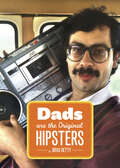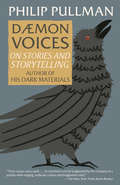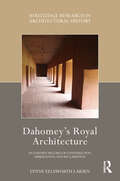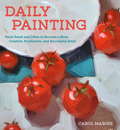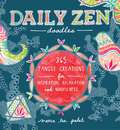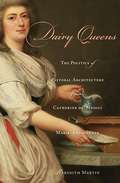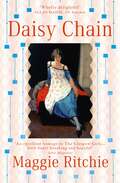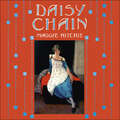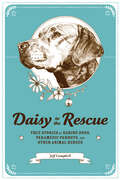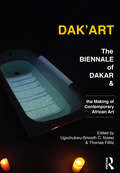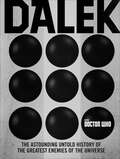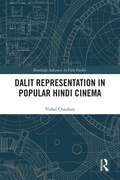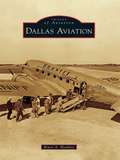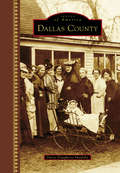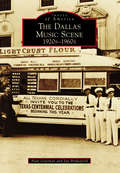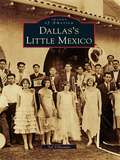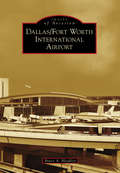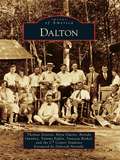- Table View
- List View
Dadaji's Paintbrush
by Rashmi SirdeshpandeOnce, in a tiny village in India, there was a young boy who loved to paint. He lived with his grandfather, who taught him to paint with his fingers, to make paints from marigolds and brushes made from jasmine flowers. Sometimes, the village children would watch them painting together, and the boy's grandfather would invite them to join in.They didn't have much, but they had each other.After his grandfather dies, the boy notices a little box wrapped in string with a note that read: "From Dadaji, with love," with his grandfather's best paintbrush tucked away inside. But he feels he will never want to paint again.Will the boy overcome his grief and find joy in painting and his dadaji's memory again?From Rashmi Sirdeshpande and Ruchi Mhasane comes a lushly illustrated tale of love, art, and family.
Daddy Calls Me Man
by Angela Johnson Rhonda MitchellIn four vibrant verses a young boy revels in the everyday pleasures of growing up in a family of fine artists. A still life of shoes inspires Noah to measure his own little ones against the big ones of his father. The whirl of an abstract painting encourages him to spin with his older sister. The moon outside his window is the same one that glows on his mother's canvas. But the subject that brings out the best in Noah -- and inspires his daddy to call him a man -- has her crib right there in his parents' studio. This book is a celebration of art and an exaltation of family.
Daddy Wouldn't Buy Me a Bauhaus: Profiles in Architecture and Design
by Janet AbramsDaddy Wouldn't Buy Me a Bauhaus collects the unparalleled writings of legendary British wordsmith Janet Abrams for the first time. From pivotal figures in international modernism to the pioneers of digital medium, Abrams explored the ideas, theories, and emotions that fueled their work.The book's twenty-six profiles, written in Abrams's signature, personal, often hilarious style, include Reyner Banham, Berthold Lubetkin, Philip Johnson, Paul Rand, Phyllis Lambert, Frank Gehry, Rem Koolhaas, Muriel Cooper, April Greiman, and Michael Bloomberg. Many of the profiles are back in print for the first time, having originally appeared in Blueprint, I.D. magazine, the Independent, and in books and catalogs from the 1980s through the early 2000s. A foreword by Blueprint's founding editor, Deyan Sudjic, and new reflections by Abrams set the stage.
Daddy's Ties
by Shirley BotsfordDo you have a bag of men's ties stashed away somewhere, just waiting for a good project idea? You can stop wondering what to do with those ties that your dad or husband no longer wears. Use them to make pillows, lamp shades, wall quilts or art-to-wear. Create new treasures from old ties that are probably the same ones that you have given as gifts on Father's Day, birthdays and Christmas. Shirley Botsford's glorious book is packed with over 30 functional and keepsake projects. Included are full-size patterns, step-by-step instructions and illustrations, plus inspiration, ideas, tips and techniques to create even more.
Dade City
by Madonna Jervis WiseDade City was named for Maj. Francis L. Dade, who perished in the Dade Battle, which opened the Second Seminole War in 1836. As the county seat, formality intermingles with frontier roots in a revered, historic courthouse, a stately jail, and an array of churches and historic homes. Dade City entices visitors with antique shops, cafés, and historical architecture. Folks are drawn to the hospitality of the Kumquat Festival, the homespun county fair, and agricultural showcases at area ranches. In 1908, O. Henry included Dade City in one of his short stories as a symbol of Americana. Surrounding the historic town are alluring places that tell the stories of Florida: the Withlacoochee State Forest, Lake Jovita, Trilby, Lacoochee, and San Antonio to name a few.
Dads Are the Original Hipsters
by Brad GettyFrom the beloved blog comes this hilarious vintage photo collection of the OG hipsters, real dads in their glory days looking cooler than you’ll ever be.He listened to vinyl before you did. He drank whiskey before you did. He had a mustache before you did. Admit it: your dad was a hipster before you were! Based on the blog phenomenon of the same name, this book celebrates dads as the original hipsters. Vintage photos of real dads back in the day—in their short shorts and tight tees playing arcade games—accompany snarky captions that at once tip a cap to Dad’s glory days and poke fun at modern hipsters. Featuring tons of never-before-seen content, this book is perfect for dads, hipsters, and those who love to tease them!
Daemon Voices: On Stories and Storytelling
by Philip PullmanFrom the internationally best-selling author of the His Dark Materials trilogy, a spellbinding journey into the secrets of his art--the narratives that have shaped his vision, his experience of writing, and the keys to mastering the art of storytelling.One of the most highly acclaimed and best-selling authors of our time now gives us a book that charts the history of his own enchantment with story--from his own books to those of Blake, Milton, Dickens, and the Brothers Grimm, among others--and delves into the role of story in education, religion, and science. At once personal and wide-ranging, Daemon Voices is both a revelation of the writing mind and the methods of a great contemporary master, and a fascinating exploration of storytelling itself.
Daguerreotypes: Fugitive Subjects, Contemporary Objects
by Lisa SaltzmanIn the digital age, photography confronts its future under the competing signs of ubiquity and obsolescence. While technology has allowed amateurs and experts alike to create high-quality photographs in the blink of an eye, new electronic formats have severed the original photochemical link between image and subject. At the same time, recent cinematic photography has stretched the concept of photography and raised questions about its truth value as a documentary medium. Despite this situation, photography remains a stubbornly substantive form of evidence: referenced by artists, filmmakers, and writers as a powerful emblem of truth, photography has found its home in other media at precisely the moment of its own material demise. By examining this idea of photography as articulated in literature, film, and the graphic novel, Daguerreotypes demonstrates how photography secures identity for figures with an otherwise unstable sense of self. Lisa Saltzman argues that in many modern works, the photograph asserts itself as a guarantor of identity, whether genuine or fabricated. From Roland Barthes’s Camera Lucida to Ridley Scott’s Blade Runner, W. G. Sebald’s Austerlitz to Alison Bechdel’s Fun Home—we find traces of photography’s “fugitive subjects” throughout contemporary culture. Ultimately, Daguerreotypes reveals how the photograph, at once personal memento and material witness, has inspired a range of modern artistic and critical practices.
Dahomey’s Royal Architecture: An Earthen Record of Construction, Subjugation, and Reclamation (Routledge Research in Architectural History)
by Lynne Ellsworth LarsenDahomey’s Royal Architecture examines the West African kingdom of Dahomey, located in present-day Republic of Benin. The book explores the Royal Palace of Dahomey’s relationship to the religious, cultural, and national identity of the pre-colonial Kingdom of Dahomey (c. 1625–1892), colonial Dahomey (1892–1960) and post-colonial Benin (1960–present). The Royal Palace of Dahomey covers more than 108 acres and was surrounded by a wall over two miles long. When the French colonial army arrived in Abomey in 1892, the ruling king set fire to the palace to keep it from falling into enemy hands. Though much of the palace structure was subsequently left to ruin, a portion of it was restored from which the French ruled for a short period. In 1945, the colonial administration transformed part of the palace into a museum, and in 1985 the entire palace was added to UNESCO’s World Heritage list. This book documents the palace’s physical transformations in relation to its changing purposes and explores how the space maintained religious significance despite change. The palace’s construction, destruction, and restorations demonstrate how architecture can be manipulated and transformed according to the agendas of governments or according to the religious and cultural needs of a populace. The palace functions as a historic record by discussing aspects of documentation, revision, language, and interpretation. Covering almost four centuries of Dahomey’s history, this book will be of interest to researchers and students of African art and architecture, religious studies, west African history, and post-colonial studies.
Daily Dishonesty: The Beautiful Little Lies We Tell Ourselves Every Day
by Lauren HomA colorful compendium of little white lies, based on the award-winning, &“bitingly honest&” blog (Imprint). From the diet you&’re going to start tomorrow to that call you were about to make when something (anything) else came up—life is full of little lies that get us through the day. With Daily Dishonesty, designer and blogger Lauren Hom pays homage to the (mostly) innocent foibles that make us human. With 150+ hilariously common lies, beautifully illustrated by Hom, Daily Dishonesty touches on topics from breakups, friendship, and growing up to slacking off and guilty pleasures, in hand-lettered mantras that are all too honest about our untruths. Praise for the Daily Dishonesty blog &“Simply wonderful!&” —SwissMiss &“Cleverly and adorably displays lies.&” —Complex Magazine &“Really inspiring for those of you who want to dabble in hand lettering.&” —Miss Moss
Daily Painting
by Carol MarineA unique system for jump-starting artistic creativity, encouraging experimentation and growth, and increasing sales for artists of all levels, from novices to professionals. Do you want to bring the joy back into your art? Have you landed in a frustrating rut? Are you having trouble selling paintings in galleries, getting bogged down by projects you can't seem to finish or abandon, or finding excuses to avoid working in the studio? Author Carol Marine knows exactly how you feel--she herself suffered from painter's block, until she discovered "daily painting." The idea is simple: do art (usually small) often (how often is up to you), and if you'd like, post and sell it online. Soon you'll find that your block dissolves and you're painting work you love--and more of it than you ever thought possible! With her encouraging tone and useful exercises, Marine teaches you to:-Master composition and value-Become confident in any medium-Choose subjects wisely -Stay fresh and loose -Photograph, post, and sell your art online-Become connected to the growing movement of daily painters around the worldFrom the Trade Paperback edition.
Daily Zen Doodles: 365 Tangle Creations for Inspiration, Relaxation and Joy
by Meera Lee PatelA YEAR'S WORTH OF "TANGLED DRAWINGS" DESIGNED TO INSPIRE CREATIVITY AND SERENITYWith hand illustrated prompts and thoughtful quotes, Daily Zen Doodles will inspire you to lose yourself in the contemplative act of drawing. Each page is an invitation to sketch, relax, focus and reach toward inner peace.
Dairy Queens: The Politics of Pastoral Architecture from Catherine de' Medici to Marie-Antoinette
by Meredith MartinThese garden structures―most famously the faux-rustic, white marble dairy built for Marie-Antoinette’s Hameau at Versailles―have long been dismissed as the trifling follies of a reckless elite. Martin challenges such assumptions and reveals the pivotal role that pleasure dairies played in cultural and political life, especially with respect to polarizing debates about nobility, femininity, and domesticity. Together with other forms of pastoral architecture such as model farms and hermitages, pleasure dairies were crucial arenas for elite women to exercise and experiment with identity and power.
Daisy Chain: a novel of The Glasgow Girls
by Maggie Ritchie'A wholly delightful novel' Allan Massie, ScotsmanLily Crawford and Jeanie Taylor, from very different backgrounds, are firm friends from their childhoods in Kirkcudbright. They share their ambitions for their futures, Lily to be an artist, Jeanie to be a dancer.The two women's eventful lives are intertwined. In the years before the First World War, the girls lose touch when Jeanie runs away from home and joins a dance company, while Lily attends The Mack, Glasgow's famous school of art designed by Charles Rennie Mackintosh. A chance meeting reunites them and together they discover a Glasgow at the height of its wealth and power as the Second City of the Empire - and a city of poverty and overcrowding. Separated once again after the war, Lily and Jeanie find themselves on opposite sides of the world. Lily follows her husband to Shanghai while Jeanie's dance career brings her international fame. But the glamour and dissolution of 1920s Shanghai finally lead Lily into peril. Her only hope of survival lies with her old friend Jeanie, as the two women turn to desperate measures to free Lily from danger.Inspired by the eventful and colourful lives of the pioneering women artists The Glasgow Girls, particularly that of Eleanor Allen Moore, Daisy Chain is a story of independence, women's art, resilience and female friendship, set against the turbulent background of the early years of the 20th century.
Daisy Chain: a novel of The Glasgow Girls
by Maggie RitchieLily Crawford and Jeanie Taylor, from very different backgrounds, are firm friends from their childhoods in Kirkcudbright. They share their ambitions for their futures, Lily to be an artist, Jeanie to be a dancer.The two women's eventful lives are intertwined. In the years before the First World War, the girls lose touch when Jeanie runs away from home and joins a dance company, while Lily attends The Mack, Glasgow's famous school of art designed by Charles Rennie Mackintosh. A chance meeting reunites them and together they discover a Glasgow at the height of its wealth and power as the Second City of the Empire - and a city of poverty and overcrowding. Separated once again after the war, Lily and Jeanie find themselves on opposite sides of the world. Lily follows her husband to Shanghai while Jeanie's dance career brings her international fame. But the glamour and dissolution of 1920s Shanghai finally lead Lily into peril. Her only hope of survival lies with her old friend Jeanie, as the two women turn to desperate measures to free Lily from danger.Inspired by the eventful and colourful lives of the pioneering women artists The Glasgow Girls, particularly that of Eleanor Allen Moore, Daisy Chain is a story of independence, women's art, resilience and female friendship, set against the turbulent background of the early years of the 20th century.(P) 2021 Hodder & Stoughton Limited
Daisy to the Rescue: True Stories of Daring Dogs, Paramedic Parrots, and Other Animal Heroes
by Jeff CampbellWith their love and companionship, animals of all species help to make human lives better every day. But sometimes, to our utter amazement and everlasting gratitude, animals literally save our lives. This heartwarming book collects over 50 real-life stories in which the actions of animals have meant the difference between life and death. Today, scientists vigorously debate questions regarding the sentience, intelligence, and emotions of animals. In particular, they want to know whether animals share with humans the highest emotions of empathy, compassion, and altruism. Daisy to the Rescue poses these questions for readers to consider, and examines these extreme life-saving situations for possible evidence. Gathered together, these stories make a compelling case for the presence of altruism in animals. Daisy to the Rescue provides dramatic, thrilling, and moving stories that convey a hopeful message about our world. But these stories also provide startling evidence of the mental and emotional capacities of animals, those beings we share the world with.
Dak'Art: The Biennale of Dakar and the Making of Contemporary African Art (Criminal Practice Ser.)
by Thomas Fillitz Ugochukwu-Smooth C. NzewiWhat can an art biennale in Dakar, Senegal, tell us about current discourses surrounding the place of art in the world, and in the academic study of anthropology? This volume investigates the Dak'Art biennale, ranked among the world's top 20 biennials, drawing upon fieldwork, archival research, and the experiences of those involved. In so doing, the chapters make a statement about the impact of globally-acting art biennials, contributing to current scholarship both on biennales and the anthropology of art scene more widely. Part I opens with the history of its foundation and considers it in conjunction with the rise of contemporary art in Senegal. Part II deals with the biennale's various objectives, selection strategies, exhibition spaces, platforms for debate, and discourses between the State, the secretariat and local artists and art world professionals. Part III examines the cyclical creation of contemporary African art, and questions if the Biennial creates local canonical practices. The Epilogue uses the Dak'art biennale to question assumptions around practice in general biennale scholarship and work. Featuring a dialogic structure between practitioners of art and anthropologists, this unique volume will be of interest to students of anthropology, art history and practice, African studies and curatorial practice.
Dalek: The Astounding Untold History of The Greatest Enemies of the Universe (Doctor Who Ser. #72)
by George MannFor the first time, the never-before-told history of the Doctor’s most dangerous enemy, the Daleks, from their genesis thousands of years ago to their conquest of the universe.Doctor Who: Dalek, is the one and only volume devoted solely to the history of the Doctor’s greatest enemy. The Daleks, with their watchword cry "Exterminate!", are a race of cyborg aliens single-mindedly determined to conquer the universe and end all life forms they consider inferior. First appearing on Doctor Who in 1963, the Daleks are among the show’s most popular villains. Reminiscent of human-sized pepper shakers, the external mechanical casing of the Dalek protects a soft, repulsive creature whose electronic voice is reduced to a squeak when outside of its shell.Doctor Who: Dalek chronicles the Daleks’ genesis through the Time War and their ongoing conquest of the universe. Here are never-before-told stories about these legendary creatures—including terrifying near-mythical adventures, startling visual recreations of secret conflicts, and more. Each story sheds new light on what has become the most feared alien race in the universe.With a foreword by showrunner Steven Moffat, full-color illustrations, concept art, cutaways, diagrams, comic strips and more, Doctor Who: Dalek is the ultimate celebration of all things Dalek and a must have for devoted Whovians of every age.
Dalit Representation in Popular Hindi Cinema (Routledge Advances in Film Studies)
by Vishal ChauhanThis book explores the dynamics of caste in Bollywood and popular Hindi cinema through an examination of the representation of Dalits since the 1930s.Drawing on critical textual analysis and historical analyses of a number of key films, the author argues that popular Hindi cinema corroborates in the construction, naturalisation, and dissemination of Dalit stereotypes in line with the dominant culture, on the one hand, and ignores the Dalit history of struggle against caste discrimination, on the other hand. The book maps the evolution of Dalit representation from the 1930s to the 2000s. In doing so, it addresses the continuity and shifts in their portrayals and explores the linkages between the cinematic representation of Dalits and real- world power structures.This book will be of interest to scholars and students working in film studies, film history, cultural politics, sociology, and cultural studies.
Dallas Aviation (Images of Aviation)
by Bruce A. BleakleySince Otto Brodie's airplane flight at Fair Park in 1910, the city of Dallas has seen over 100 years of rich and diverse aviation activity. Many of those years were spent on a long and complex road to a consolidated airport for the Dallas-Fort Worth area, an impasse finally resolved with the dedication of Dallas-Fort Worth Regional Airport in 1974. Central to Dallas aviation history is Love Field, established as a military base in 1917. A waypoint for famous flights such as the first round-the-world flight in 1924, a venue for colorful characters like barnstormer and bootlegger "Slats" Rodgers, and the site of World War II's largest Air Transport Command base--Love Field was all this and more. Although no longer the region's primary commercial airfield, Love Field remains a major aviation facility as the home of Southwest Airlines and several internationally recognized business aircraft operations.
Dallas County (Images of America)
by Darcy Dougherty-MaulsbyNo Iowa county has influenced American history more than Dallas County. It propelled Harry Truman to an unlikely victory in the 1948 presidential campaign, following a fiery speech he delivered to 100,000 farmers on a sweltering September day at the National Plowing Match near Dexter. Just 15 years earlier, a shoot-out near Dexfield Park marked the beginning of the end for infamous outlaws Bonnie and Clyde and the notorious Barrow Gang. Dallas County, located just west of Des Moines, has produced several major-league baseball players (among them Bob Feller and Hal Manders), a US congressman (David Young), and Nile Kinnick, the 1939 Heisman Trophy winner and University of Iowa football legend whose grandfather George Clarke, of Adel, served as Iowa’s governor from 1913 to 1917. Today, Dallas County is one of the fastest-growing counties in America and remains a region of opportunity with a rich heritage of small-town living, farming, coal mining, and the immigrant experience.
Dallas Music Scene: 1920s-1960s, The
by Alan Govenar Jay BrakefieldFor much of the 20th century, Dallas was home to a wide range of vital popular music. By the 1920s, the streets, dance halls, and vaudeville houses of Deep Ellum rang with blues and jazz. Blind Lemon Jefferson was discovered singing the blues on the streets of Deep Ellum but never recorded in Dallas. Beginning in the 1930s, however, artists from Western swing pioneer Bob Wills to blues legend Robert Johnson recorded in a three-story zigzag moderne building at 508 Park Avenue. And from the late 1940s to the mid-1960s, a wrestling arena called the Sportatorium was home to a Saturday night country and rock-and-roll extravaganza called the Big "D" Jamboree.
Dallas's Little Mexico (Images of America)
by Sol VillasanaLittle Mexico was Dallas's earliest Mexican barrio. "Mexicanos" had lived in Dallas since the mid-19th century. The social displacement created by the Mexican Revolution of 1910, however, caused the emergence of a distinct and vibrant neighborhood on the edge of the city's downtown. This neighborhood consisted of modest homes, small businesses, churches, and schools, and further immigration from Mexico in the 1920s caused its population to boom. By the 1930s, Little Mexico's population had grown to over 15,000 people. The expanding city's construction projects, urban renewal plans, and land speculation by developers gradually began to dismantle Little Mexico. By the end of the 20th century, Little Mexico had all but disappeared, giving way to upscale high-rise residences and hotels, office towers of steel and glass, and the city's newest entertainment district. This book looks at Little Mexico's growth, zenith, demise, and its remarkable renaissance as a neighborhood.
Dallas/Fort Worth International Airport (Images of Aviation)
by Bruce A. BleakleyEncompassing 27 square miles, Dallas/Fort Worth International is one of the world's largest and busiest airports, accommodating more than 150,000 passengers each day. The 1974 opening of "D/FW" was preceded by nearly half a century of an often acrimonious aviation rivalry between Dallas and Fort Worth that featured a colorful cast of business leaders, municipal officials, and airline executives. Through its first 40 years, D/FW grew from a regional hub into a global crossroads for passenger and air cargo service. Bold, imaginative leadership sustained the airport through the failure of its largest tenant airline, the effects of 9/11, an air traffic controllers' strike, and more than one fuel crisis. An extraordinary economic engine for North Texas, D/FW stands poised to become home to the world's largest airline, validating the original planners' dream of a dynamic focal point for domestic and international commercial aviation.
Dalton
by Myra Owens Tammy Poplin Thomas Deaton Vanessa Rinkel Brenda OwnbeyThe Cherokees who first occupied this area called northern Georgia their "enchanted land," but the discovery of gold caused a land rush, an illegal treaty of expulsion, and the Trail of Tears. Dalton was created when the Western and Atlantic Railroad was built to connect Atlanta with Chattanooga, Tennessee. In 1863, during the Civil War, this small town became a battle scene along Gen. William T. Sherman's march, with both armies occupying the community. After the war, the leading citizens built Crown Cotton Mill and Village to expand the town's economy. In 1895, fifteen-year-old Catherine Evans hand-tufted a bedspread, ushering in the bedspread and tufted carpet bonanzas. With the invention of tufting machines in the 1930s and 1940s, Dalton boomed as carpet companies, supply houses, bedspread lines, and retail outlets brought wealth to the city. At one point, there were more millionaires per capita in Dalton than anywhere in the country. Today Dalton is growing with the help of a diverse Hispanic labor force and continues to be the Carpet Capital of the World.
